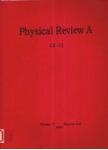版权所有:内蒙古大学图书馆 技术提供:维普资讯• 智图
内蒙古自治区呼和浩特市赛罕区大学西街235号 邮编: 010021

作者机构:Centre for Quantum Computing Technology School of Physics University of Melbourne Victoria 3010 Australia Hewlett-Packard Laboratories Filton Road Stoke Gifford Bristol BS34 8QZ United Kingdom Centre for Quantum Photonics H. H. Wills Physics Laboratory and Department of Electrical and Electronic Engineering University of Bristol Merchant Venturers Building Woodland Road Bristol BS8 1UB United Kingdom National Institute of Informatics 2-1-2 Hitotsubashi Chiyoda-ku Tokyo 101-8430 Japan
出 版 物:《Physical Review A》 (物理学评论A辑:原子、分子和光学物理学)
年 卷 期:2007年第76卷第5期
页 面:052312-052312页
核心收录:
学科分类:070207[理学-光学] 07[理学] 08[工学] 0803[工学-光学工程] 0702[理学-物理学]
主 题:QUANTUM COMPUTATION LINEAR OPTICS GRAPH STATES COMMUNICATION COMPUTER QUBIT REPEATERS CIRCUIT
摘 要:Photonic entanglement has a wide range of applications in quantum computation and communication. Here we introduce a device: the photonic module, which allows for the rapid, deterministic preparation of a large class of entangled photon states. The module is an application independent, “plug and play device, with sufficient flexibility to prepare entanglement for all major quantum computation and communication applications in a completely deterministic fashion without number-discriminated photon detection. We present two alternative constructions for the module, one using free-space components and one in a photonic band-gap structure. The natural operation of the module is to generate states within the stabilizer formalism and we present an analysis on the cavity requirements to experimentally realize this device.